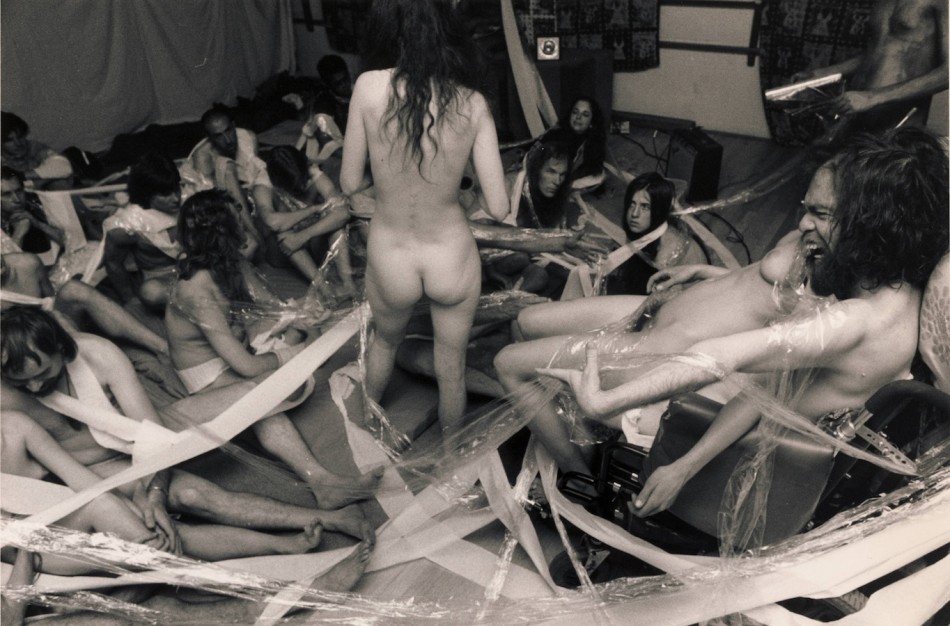
"Communication Room", U.C.B. Series, Berkeley, 1983. Photo: Mary Sullivan
“We Misfits Are Still Needed”: A Performance Conversation with Frank Moore
Editor’s Note: Frank Moore died on October 14, 2013. The writer dedicates this interview to Moore, “a brave and dedicated artist.”
A body-centered performance artist, Frank Moore’s work has been labeled obscene by the mainstream for over three decades. Along with Annie Sprinkle and Karen Finley, his contemporaries, his work employs nudity and erotic play as artistic devices. Moore, 67, streams his video archive on his Vimeo channel, where the work has had over seven million views. (Debates about whether the work is exploitative or acceptable rage in the comment section.) I am transfixed by the nine-and-a-half-minute video clip of Frank Moore eating from the early 1980’s — a performance video he created while a master’s student at The San Francisco Art Institute. The video repels, yet intrigues; it makes me feel very uncomfortable. Frank Moore’s performance art seems to command this physical rather than intellectual response. He uses his body to expand the field of communication between performer and audience. I interviewed Moore by email.
I am curious about your childhood: where you grew up, what you dreamt about . . . .
My first stroke of good luck was I was born spastic with cerebral palsy, unable to feed myself, walk or talk. Add to this good fortune the fact that my formative years were in the sixties — my fate was assured!
During [my] first year, it became more and more obvious that things weren’t “normal.” The doctors told my parents that I had no intelligence, that I had no future, that I would best be put into an institution and forgotten. This was a powerful expectation, with all the force of western science and medicine, as well as social influences, behind it. It would have been easy for my parents to be swept up into this expectation. Then that expectation would have created my reality. I would have long ago died without any other possibilities.
Instead, my parents rejected this expectation for the possibility they saw in my eyes, for what, for them, should have been true. They had to passionately live their choice every day, every minute, or the cultural expectation would have sucked them, and me, into it.
You are one of the NEA-funded performance artists who were targeted by conservative lawmakers in the 1990’s, which resulted in the NEA no longer funding individual artists.
It was not about stopping funding artists. Annie Sprinkle had not even tried to get NEA funding when we were targeted, and I just had gotten an NEA fellowship of five thousand dollars! The core goal of this attack was to politically de-ball all art. All of us targeted artists (gays, women and me) were using nudity and eroticism for radical political social change.
The mainstream entertainment, by its sheer mass, has always sucked artists out of the fringe, the underground. That is just gravity. In reality, it takes a lot to enter, and to stay in, the underground. The underground is where the real freedom and the real ability to change society are to be found. This is why artists choose the underground instead of the mainstream. In my own career, I have worked very hard to stay in the underground.
How has performance art changed?
In the seventies and the early eighties, the calling of art became the career of art. The passion and idealism became the studying of the trends of what will be “in” next. The passionate vulnerability that creates magic was replaced by a cool and clever intellectualism.
Performance, like any avant-garde art, is the way society dreams; it is the way society expands its freedom, explores the forbidden in safety, loosens up. Society needs its dream art, just as an individual needs to dream or will go insane.
Performance is perfectly suited for this dream role.
Does performance really interact with society?
At the present time, our society is at a fork in its growth. It can go deeper into high-tech impersonal isolation, or it can rediscover the magic that happens when physical and emotional humans actively and directly link up with one another. Art can either just follow society, just recording the trends, or it can take a path-breaker role.
[Many] artists are not as lucky as I am to have a physical reminder that they are misfits of society whose job it is to push back the limits of society. This is a reminder that we misfits are still needed.
Performance art, the art of performance, is rooted in the private games of babies, where every move and gesture has its own meaning to the baby. It is rooted in the creative and the destructive games that a little kid does when he is all alone — games that adults still do, but will not admit to doing, even to themselves.
I don’t have a choice about what the art is like; I can’t change it to suit the art fashion, to keep up with the times. It is a living monster pulling me along in its zigzag evolution. Real art is like that. Art is a calling, not a career.

Frank Moore in “An Act Of Direct Engagement”, POW! POW! Acton Art Festival at the Climate Theater, San Francisco, California, Friday, October 16, 2009. Photo: Daniel Lorenze

U.C.B. Series, Berkeley, California, Winter 1984. Photo: Mary Sullivan

Exploring The Taboos Of Intimate Fun, Center For Sex & Culture, San Francisco, California, October 15, 2011. Photo: Michael LaBash >

“Journey To Lila”, Walden Performance Space, Berkeley, California, 1990. Photo: Kevin Rice
